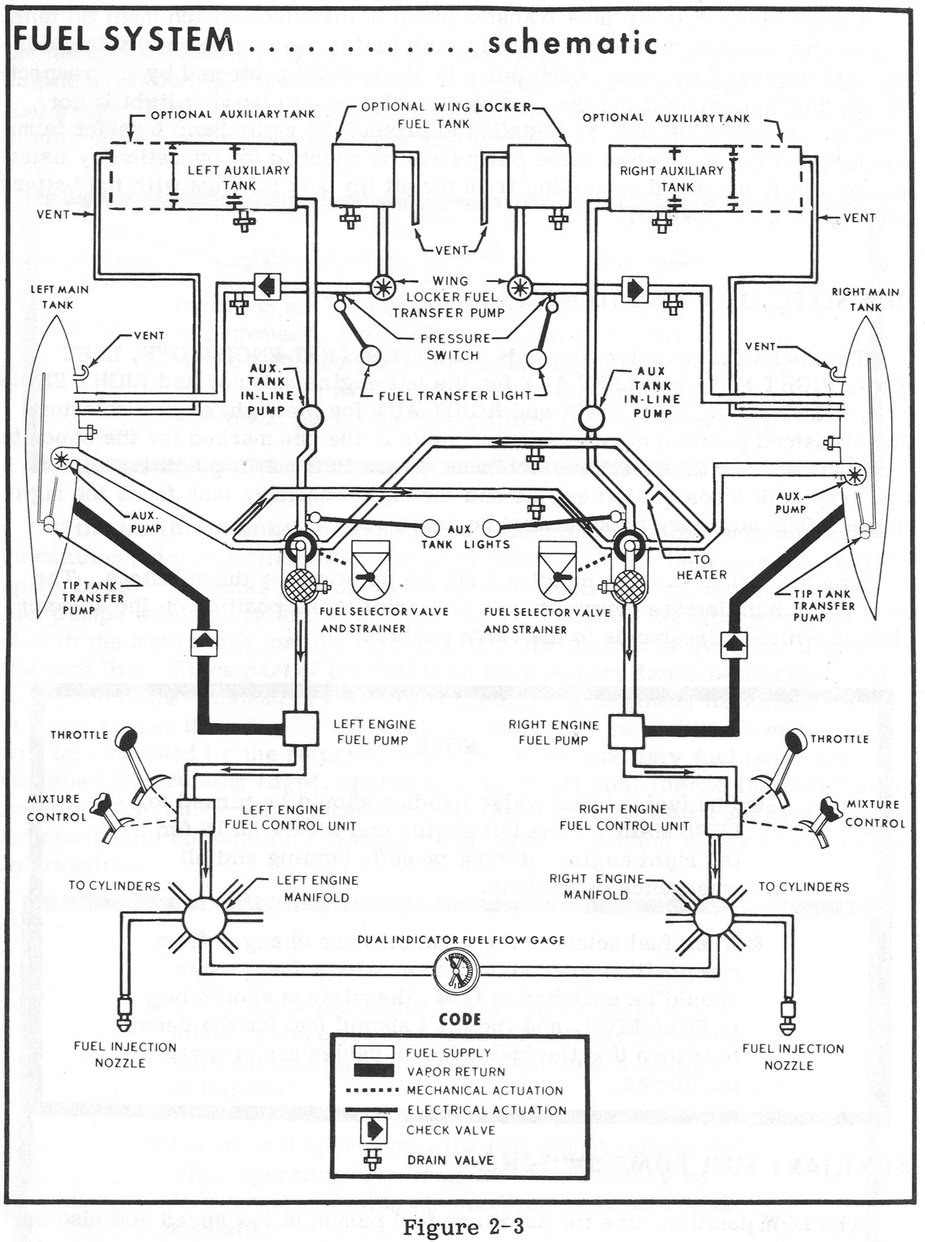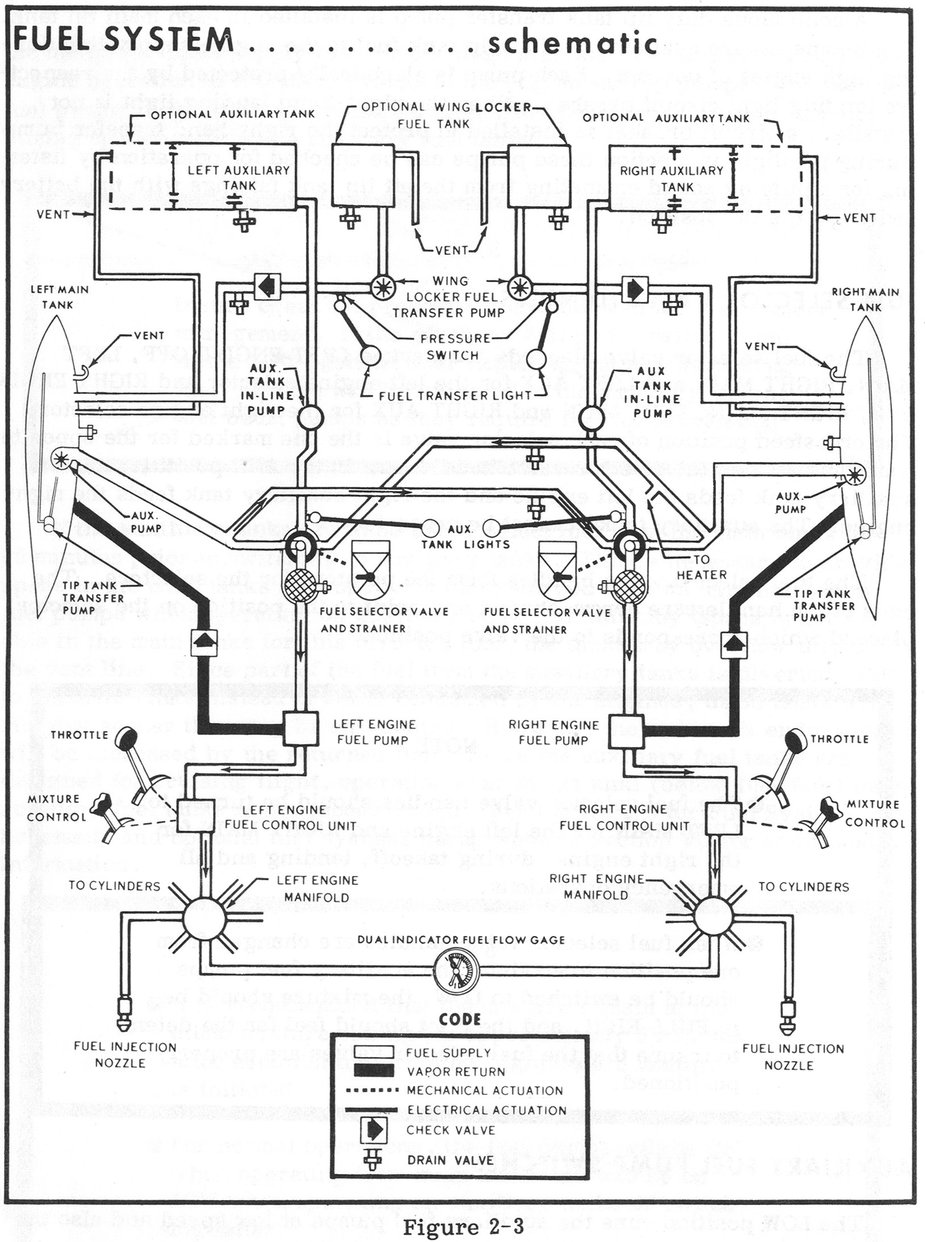If you lost control and went into a dive, there might not be the time / reflex to communicate, especially before things are under control
what_next wrote:
But so far I have not come across a 421 where the failure of one engine would influence the fuel system of the other side. They are completely independent, even when crossfeed is selected.
Quoting Hal Stoen:
There was a design “anomaly” in the 421B fuel system. The fuel pump switches were labeled “Low”, “Off”, and “On”. “On” was really “Armed”, although the switches were not labeled that way. The pumps were in-line with the fuel system and controlled by a pressure switch. The pump motors were “center-tapped”. This meant that in normal operation the pumps were driven by one-half of the ships electrical voltage- 12 volts. In this mode they acted in a fuel vapor purging capacity. Normally the engine-driven fuel pumps would supply adequate fuel to the engines.In the event of an engine-driven fuel pump failure, and if the electric pumps were in the “On” (armed) position, the pressure switch would sense this, and activate the pumps in the “full power” mode. In this mode the electric motor was no longer run off of the center tap but the full winding- 24 volts, normal ships power. At this setting these pumps could put out an incredible amount of fuel- enough fuel to flood out and stop an otherwise fully functioning engine.
We performed tests with another 421B at Minneapolis. At any setting, other than full power, if the pumps were engaged with functioning engine pumps, the engines would flood out and die. Interestingly, if the fuel selectors were placed in the “cross feed mode” (where both engines are supplied by the same fuel tank), activating the electric pump would kill both engines.
This was one very powerful pump.
If the aircraft was operating at less than full engine power, and if the electric fuel pump activated, the associated engine would power down from the excess fuel. If the aircraft was at full takeoff power and the pump became engaged, there would be no difference. However, as soon as power was reduced from full, the engine would power down.
Ultranomad wrote:
This was one very powerful pump.
Yes, because other than most auxiliary fuel pumps which will just feed fuel at ambient pressure to the carburator, this one can actually provide sufficient pressure for the injectors.
But in order to flood the opposite engine by an electric fuel pump, three things must happen:
1. The fuel selector of the remaining engine must be placed in X-feed (if he had time and control to do that – the fuel lever is down on the floor – he should have been able to call ATC as well).
2. The engine driven fuel pump of the remaining engine must be faulty in so far as it does not let the excess fuel flow back into the tank (the black lines in the diagram below labelled “vapor return” but which are really just normal excess fuel return lines).
3. The fuel control unit of the remaining engine must be faulty because it should regulate the injection pressure indepently of the fuel supply pressure.
Certainly possible that all these three occur together (and it obviously has happened to Hal Stoen) but very unlikely. In the 421 – as in most aicraft I fly – it is common practise to turn the auxiliary fuel pump on for takeoff and landing and when switching tanks or crossfeeding to correct a fuel imbalance. It’s a checklist item (not on some later modifications) – and I have never seen an engine flooded because of it.
This is the messy fuel system of a C421B:

Reminds me of the C-310 …. I would not want to deal with that stuff. If you don’t fly it all the time and are a fanatic about that stuff you can never be on top of the game and in case something breaks things become critical quickly …
Alexis wrote:
Reminds me of the C-310 ….
It’s basically the same. And it has claimed quite a few lives over the years.
Alexis wrote:
I would not want to deal with that stuff.
If you know how it wants to be operated it is not so horribly bad. But if you fly an aircraft like this only a couple of times per year and something goes wrong you can get into real trouble real quick. But again, I can hardly imagine that obscure fuel system issues have caused this crash. Crossfeeding comes very late in the list of things one has to do after an engine failure. Almost everything else comes first, including landing at a nearby airfield.
If I would be investigating this, this bit from the initial posting would make me think: “…flew low around Prague CTR and climbed to FL140 north-eastbound.” That looks like a VFR flight to me. The weather was not really VFR along his path – so I would start my investigation there.
Yes, that’s what I mean. I always had the opinion that these planes are not for amateurs who don’t really fly much. I have flown the C-310 once, with an instructor, I had really had no idea what he was talking about. The full flight simuator of the Eurofighter was a piece of cake compared to that ;-)
As What_Next has shown…Heath Robinson would have had a field day with this mess…

Ultranomad wrote:
The aircraft spiralled for eight to ten seconds and then simply fell on its belly
The pictures show that the empennage is essentially undamaged, so the aircraft can’t have crashed “on its belly”, but rather nose-first.
It was IFR flight on IFR flight plan with FL180 as final cruising level according to the plan. The destination was Gdansk. The reason why it was kept low around Prague CTR were arrivals to RWY06 at LKPR, which is rather unusual RWY at Prague, 90% of time it is RWY24. I flew to LKPR yesterday and we were one of four aircraft landing on RWY06, getting several speed restrictions during the approach for spacing whilst at least four other aircraft were waiting for departure. I can understand that departing piston traffic was not very welcome in Prague CTR and was routed around.
METAR LKPR 260530Z 09009KT 5000 BR NSC 11/10 Q1023 NOSIG=
TAF LKPR 260500Z 2606/2712 09008KT 7000 SCT023
TEMPO 2606/2608 4000 BR BKN006
BECMG 2608/2610 11008KT 9999 SCT030
BECMG 2616/2619 07004KT CAVOK
BECMG 2621/2623 VRB02KT 3000 BR NSC
BECMG 2623/2701 0600 FG VV002
TEMPO 2701/2705 0200 FG VV001
BECMG 2705/2708 11006KT CAVOK=